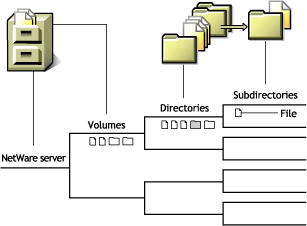5.1 Directory Structures
The NSS and Traditional file systems provide a uniform method of referring to directories and files and locating them on a variety of storage media. As with your office filing system, you must impose organization on data you store in a volume. Within each volume, you can group information in logical containers called folders or directories.
A directory is a logical separation within a volume where you store files and subordinate directories, called subdirectories. The directory is a special type of file that contains a list of its files and subdirectories. It can also contain metadata about the directory, such as who can access it and its attributes. For NetWare Traditional, the directory’s metadata is stored in a Directory Entry Table (DET), separate from the directory itself.
A file is the basic logical container for storing information, such as an image, a document, a program, text, or a database.
Within each volume, the directory structure is hierarchical. It is an inverted tree structure with a single root. The topmost directory in the hierarchy is called the root directory. A directory is called the parent directory of the subdirectories and files in it. A volume can contain any number of directories. A directory can contain any number of files and subdirectories.
The following figure illustrates how volumes are similar to drawers in an office filing cabinet that contain related information. For example, the sys: volume on NetWare contains the operating system and its extensions. Other volumes might contain applications, corporate data, or user home directories and files.
Figure 5-1 Sample Directory Structure for NSS and Traditional File Systems on a NetWare Server

There is no one best solution for organizing files with directories. You can use a combination of approaches, such as by geographic location, applications, business units, projects, or owners. For information, see Planning Directory Structures for NetWare Servers.
To control who can access directories and files on your NSS and Traditional NetWare file systems, you must assign file system trustees, trustee rights, and inherited rights filters. For information, see Section 8.2, File-System Trustee Rights.
To control how authenticated users can use directories and files, you must set directory and file attributes. For information, see: